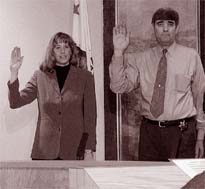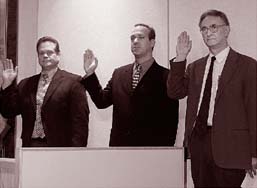|
Jan. 9, 2003 "I do solemnly swear"TEN COUNTY OFFICIALS WERE SWORN IN AT A MASS ceremony at noon Monday with Judge Marilyn Miles doing the honors. Most of the representatives and administrators are new to their jobs. With that in mind, the Journal asked: "What is the first thing on your agenda?" Incoming D. A. Paul Gallegos' chief task: "Meet with the troops. Deal with the chaos of moving in." And then? Gallegos said rewriting the county's Proposition 215 medical marijuana policy is one of the first things he will work on. Said Supervisor Jill Geist, "Learn about the dynamics of the organization and figure out its inner workings so I can see where I fit in and how I can best serve the 5th district. And I want to develop relationships with the community across a broad base." Big problems to tackle? "No. 1 is the budget crisis. And water issues with the Klamath, the Eel, the Trinity -- all the rivers -- that will be a top priority." Superintendent Garry Eagles did not have to think long. His primary concern: "School survival in the face of the state's budget crisis. Then I want to be an advocate for rural education," he added. Assessor Linda Hill was all business. "My main focus is on continuing to run the office in a professional, efficient manner," she said. Will budget troubles make her job harder? "The budget crisis will make it more difficult, but not too bad. We will have to learn to live with it." Auditor-Controller Michael Giacone was thinking about mending fences. "First thing is to get together with the CAO [new County Administrative Officer Loretta Nickolaus] and begin reestablishing a good working relationship. In previous years we've had some tough times [with prior CAO John Murray]." Sheriff Gary Philp was not looking at his first day on the job. He has already replaced former Sheriff Dennis Lewis who retired in September. On the top of Philp's mind: a campaign promise fulfilled. "We opened up the new McKinleyville office today with a sergeant, three deputies, a community service officer and a clerk on duty," he said. "They'll be there from 8-4:30, Monday through Friday." Will things be different with a new D.A.? ""Not really. We both have the same idea: provide the best law enforcement we can. We will work together to do that."
Above, Left to right:
Above, Left to right:
The Jacks could be headed for a national championshipby ANDREW EDWARDS Before the players take the court there is a moment of almost dead calm. A soft murmur rises from the near-capacity crowd in the pull-out bleachers. You can smell the varnish on the polished hardwood floor. And then -- the house erupts. First the visitors, then the home team hits the floor, their starting lineups firing off balls to cheers and horn blasts from the Marching Lumberjacks. From then on it's all game. The chants of the crowd -- "defense, defense" -- the swoosh of a shot hitting nothing but net, the pounding of basketballs, the squeak of green Adidas and blue Nikes as players stop and start, the piercing whistles of the zebra-striped referees, the screaming of suited coaches, foreheads drenched in sweat, leaning into the game as if they wished they were the ones playing this Saturday night in Humboldt State University's East Gym. Fortunately for the fans, they're not. Instead, the No. 1 NCAA Division II team in the nation, unbeaten so far this season, is putting on another show. In the last three years the Lumberjacks have moved from relative obscurity to a position of domination in their league, a ten-team affair that includes schools stretching from Northern California to Alaska. Now the Jacks, who whipped Notre Dame de Namur 85-59 Saturday night, are poised for a shot at the national championship, the first in the school's history. So what makes this team so special? "Everybody's got a will to win, winners have a will to prepare to win," said head coach Tom Wood, in an interview in the weight room where the team was working out after last Thursday's practice. He said the players work hard and are coachable -- meaning they are willing to take direction and run with it. Most important of all -- they are talented. Wood, a Humboldt County native, has been the men's basketball coach at HSU for 23 years now -- an unusually lengthy stay -- and although he has maintained a winning record overall of 301-285, he's never had a team like this. Why? He peered over his glasses and answered: "It starts with talent. I'm not that much smarter than I was two, four, five, six years ago." There's no question this is an astonishingly talented team. Two players -- Austin Nichols of Berkeley and Fred Hooks of San Diego -- are the Jacks' No. 1 and No. 3 top scorers ever, with a season-and-a-half left to play in their college careers. It's not just this pair, either; the entire team seems to be good; it has to be just to fuel the Jacks' energetic playing style, which calls for constant player rotation to keep the team fresh. "We play a lot of [different] people," Wood said. "They're all good and they all deserve to play." So what brought this level of talent to a school without a storied athletic tradition, at least in basketball? In a word: money. HSU has been an NCAA Division II school since 1980, but five years ago the Jacks changed leagues, leaving the Northern California Athletic Conference, which did not allow scholarship awards. The new league, the Great Northwest Athletic Conference, not only allowed scholarships, it required them. The only problem then was where to get the money. At this point Wood stepped in with his plan. He went to the administration and offered to raise the money himself since state funds can't be used for athletic scholarships. He said if other athletic teams at the university thought it unfair, or if it conflicted with federal Title 9 requirements, which mandates equal financing for men's and women's sports, he would raise additional money. "I was willing to raise $20,000 to get $10,000, if I had to," Wood said. The fund-raising campaign was a success and three years ago Wood sent his long-time assistant, coach Steve Kinder, out on the road to get some players. "Give Coach Wood all the credit. He had the vision to put me out on the road for that entire year to concentrate on recruiting," Kinder said in an interview Monday in the lobby of the basketball gym. (Kinder was so successful at recruiting that he teaches a graduate class on the subject.) That year the Jacks were losing seven senior players, but they finally had the money to offer some full-ride scholarships, about $8,500 per year, to cover tuition and books, as well as room and board. The recruiting process starts early, the summer after a recruit's junior year of high school. Recruiters like Kinder travel around to high school tournaments and scouting venues looking for promising athletes. From that preliminary look, a list is made of 200 to 500 soon-to-be high school seniors. Calls are placed to coaches, basically asking for a character reference -- if the student has had any trouble with the law, is a good citizen and if he's coachable, if he plays hard in practice, listens to directions and is always on time. "It doesn't sound like much, but it's very important," Kinder said. If they pass the character test, it's on to academics. High school transcripts are requested, grades and GPA's are checked to see if an athlete qualifies to play for a NCAA school. At this point the initial calls are made. Kinder, or one of his graduate students, calls and informs the athlete about HSU. They have to be straight up right away about the drawbacks. In no particular order, they are: HSU has a very small facility, which seats just 1,400 spectators. ("One of the worst Division II facilities for basketball on the West Coast," Kinder said. "I know; I've seen them all.") Then there's the climate. (Since most of the recruits are from Southern California, rain is a factor.) And, then there is the reputation -- or stigma -- that Humboldt is a mecca for the marijuana culture. If a student is interested, the next step is a campus visit where they are flown up for a couple of days to check out the school and meet their future teammates. "The No. 1 selling point is having them our meet our players," Kinder said. "They are not only great players, they are really, really good people -- great guys to be around. Once (recruits) meet them, they're sold." Top recruits are offered scholarships from the department's limited resources. According to Assistant Athletic Director Dan Pambianco, only four full-ride scholarships are offered to HSU men's basketball athletes. Others get partial scholarships. The maximum allowed is 10 and most schools do just that, leaving HSU at a disadvantage. Nevertheless, did fund-raising efforts pay off? "Yeah, it got `em," said Wood, speaking of those who are now the juniors on the team. Ten recruits eventually committed to HSU three years ago, the bulk of today's winning team. In an average year one to seven recruits commit to joining the Jacks, but as Kinder goes out to recruit this summer he will have a new advantage: a team with a 23 home-game winning streak, a 9-0 season so far, and the Jacks' No. 1 ranking as of this week. It's an exciting thing, but the stars of today seem to be taking their No. 1 status (out of 290 Division II schools nationwide) in stride. As Fred Hooks, the star forward, put it, "Since we were freshmen we all wanted to be national champions. We were a long way from it then, but we put in a lot of work and have gotten better every year since. We just have to stay on top now and keep up the good work." Wood remembered the team's freshman dream. He said he didn't know what to think when they said the championship was their goal, but when he saw them in action he knew. "I thought the sky was the limit with this group," Wood said. Nichols, another star, did acknowledge feeling a little bit in awe of their achievements, however. Speaking outside the gym after practice, Nichols said, "When we're playing we try not to think about it, but off the court everyone's thinking: Wow, we're No. 1 in the nation right now." Water district weighing water bag proposalby KEITH EASTHOUSE The Humboldt Bay Municipal Water District is evaluating a proposal that calls for hauling thousands -- perhaps millions -- of gallons of water from Humboldt County to thirsty coastal communities in the central and southern part of the state. Carol Rische, general manager for the district, refused to confirm or deny that the utility was weighing the proposal being pushed by Alaska businessman Ric Davidge to have tug boats tote fresh water from Humboldt in enormous polymer bags to points south. But Davidge, president of Aqueous, Inc., a water export company based in Anchorage, said in a telephone interview late Tuesday afternoon that his proposal will be the subject of a press conference the district has scheduled for Jan. 17 in Eureka. "They have taken a serious look at our proposal and that's what they will talk about" at the press conference, said Davidge. "We're the only proposal on the table." Davidge said that a minimum of 185 to 200 new jobs would be created on the hauling vessels alone. The vessels would provide Humboldt water to nine coastal communities, most if not all of them south of San Francisco Bay, Davidge said. The proposal also calls for the construction of a bag assembly plant on the Samoa Peninsula. Davidge said the infrastructure for pumping water is already present in the form of large volume pipelines that used to service pulp plants. He said the bags -- essentially huge bladders the length of three football fields -- would be filled up in the bay and then hauled out into the ocean. He said the bags would "float at or below surface of water, so you can't see them when you're standing on the beach." He also said they don't create the wake that ships or large barges do and that they are not susceptible to wave or wind energy. "When a swell hits a hard surface vessel it will push it towards the beach. But the energy in the swell goes right through the water in the bag." He said water bag technology is used in the Mediterranean and that great strides have been made in the last three or four years in terms of developing bags that are impermeable and stable. He called the technology far less of a threat to the environment compared to tankers. The water district, which furnishes residents of Eureka, Arcata and McKinleyville -- basically all Humboldt Bay communities north of Fortuna -- with drinking water, has for some time advertised on its website the fact that it possesses excess water for sale -- 20 million gallons worth. Davidge said "that's more than we would purchase," but that his company is interested "in a significant amount" of that unused water. Davidge declined to specify how much his company is offering for the excess water. He said the proposal has been before the district for some time and that it was formulated during the course of four visits to the Humboldt Bay area. Davidge is the former director of water for the state of Alaska. He was an official in the Interior Department under President Reagan. Last month, the California Coastal Commission rejected Davidge's controversial proposal to haul Mendocino County river water to San Diego. Davidge said he withdrew the proposal before the commission's Dec. 13 vote after state officials told him it would cost up to $2 million to conduct the minimal environmental studies for his plans. Davidge said he is not sure whether he would need the approval of the coastal commission for the project before the Humboldt water district. Coastal commission staff could not be reached for comment. Report blames Klamath fish kill on low flowsby ANDREW EDWARDS Take fish, reduce water and what do you get? Dead fish. That's what 33,000 dead salmon and steelhead showed everyone the hard way in last September's record breaking fish kill, and it was all the federal government's fault according to a new report from the California Department of Fish and Game. The report, released last Friday, concluded that only one variable was responsible for the kill, a lack of water caused by some of the lowest flows out of the federal Bureau of Reclamation's Upper Klamath River in generations. Other factors that were preliminarily tossed around as causes, such as high water temperatures, an unusually large run of fish, an early run or toxic substances in the river were all debunked in the report. The 63-page document stated that water temperatures were normal for September in the lower Klamath, the run (132,600 fish) was just slightly above average and that testing had confirmed that there was nothing toxic in the water. What killed the fish, according to the report, was overcrowding. There was too little water for the slightly above average run, causing disease to run rampant. Call it a deadly traffic jam. After complaints that low diversions for irrigation had caused the farmers over $200 million in losses in 2001, the reclamation bureau released its 10-year plan for water use. By using drought years in the early `90s to ascertain "average" flows they justified greatly reduced flows. Rep. Mike Thompson has taken a hard line. "I think a lot of the [federal] data was either manipulated or suppressed," Thompson said in a recent interview with the Associated Press. Thompson has proposed a bill to offer $20 million in federal aid to the fishermen and Indian tribes that were affected by the fish kill in addition to $200 million for a water conservation program to end the back and forth between fish and farmers.
Belt-tighteningHumboldt County could be facing at least $2 million in budget cuts as state legislators wrestle with closing a $35 billion deficit. Gov. Davis is proposing another round of cuts; this time he is asking for at least $10 billion in cuts statewide along with potential tax hikes. The county could be tremendously impacted by the state's deficit, said Loretta Nickolaus, county administrative officer. "We need to brace for the future," she said. Humboldt County is expecting to see a $57,000 cut in library funding, $250,000 in cuts to state-mandated programs and a $90,000 cut in managed care reimbursement for mental health programs. Additional cuts are expected to impact the county's road maintenance program, transportation program and the airport. To deal with the situation, the county may restructure its debt, which could provide an annual savings of almost $80,000. On Tuesday, the Board of Supervisors implemented a countywide hiring freeze as well as freezing all out-of-county travel paid through the General Fund. County officials hope the moves will help offset any cuts from the state. A county budget task force is recommending a hiring freeze that would allow only essential jobs, such as in law enforcement, to be filled. "We'll have to be careful how we go forward and fill positions," said Supervisor John Woolley. The County Department of Health and Human Services has taken it upon itself to freeze 84 positions, according to Nickolaus. The task force is also searching for ways to increase revenues, such as through investments that could benefit the county in the future. The task force is also calling for freezing unnecessary travel expenses; the freeze won't affect travel for county attorneys and other staff who need to travel for continuing education.
Two rock and mud slides along Highway 101 north of Confusion Hill near Piercy that shut down northbound traffic into Eureka last week will cost Caltrans almost $2 million to clean up. Removing dirt and debris and repairing support walls will take at least another two weeks, requiring Caltrans to maintain one-way traffic along that stretch of highway 24 hours a day every day. Drivers will be directed through the area by a pilot vehicle. The twin slides, about 300 feet apart, affected everything from grocery stores to postal deliveries from Garberville north. According to Anne Jones, a Caltrans spokeswoman, the 10,000 cubic yards of earth will be hauled to temporary sites north and south of the slide just to get the road open. "Eventually it will be hauled to another [storm damaged] area where fill is needed," she said. Although the mud slide was the largest in a few years, Jones said it was not the biggest to occur at that location. She didn't recall when the biggest slide occurred.
The Board of Supervisors on Tuesday proclaimed a state of emergency after winds and heavy rains last month caused soil erosion and damaged roads and bridges throughout the county. County officials expect the total cost for repairs could exceed $1 million. By declaring an emergency, Humboldt County could be eligible for state funds as well as federal loans to help businesses. Humboldt County is facing about $750,000 in road repairs alone, said Loretta Nickolaus, county administrative officer. Public Works Director Allen Campbell said his office continues to get reports of weather-related damage. The nearly $1 million price tag for repairing county roads, coupled with Gov. Davis cutting $500,000 from the county's road maintenance budget, could spell disaster if another severe storm hits the area, Campbell said. That's because public works has used up its fund reserves. The storm dumped 23.3 inches of rain on Eureka in December and brought gusts in excess of 60 mph. At one time, almost half of Humboldt County residents and businesses were without power due to the storms. In some areas, people were without power for an entire week.
Eureka Mayor Peter La Vallee is making some changes around city hall. At the Dec. 17 meeting La Vallee brought in Wiyot Tribal Chairwoman Cheryl Seidner to give the invocation, deviating from the Christian prayer common under former Mayor Nancy Flemming. La Vallee said he wants to add diversity to the invocations. La Vallee has also moved an American and California flag out of the mayor's office and onto the first floor of city hall. The flags were moved because the mayor's office is being split in two to allow one of the five council members to get a new office.
The Board of Supervisors on Tuesday took the first step toward authorizing the Humboldt Area Foundation to administer an environmental trust fund that would disburse settlements in environmental cases. The trust fund was one of the last proposals put forward by former District Attorney Terry Farmer. The foundation was chosen because of its ability to solicit grant applications, determine how funds should be handled in accordance with a settlement and distribute those funds. The funds would go toward enforcement, education and restoration of the area's environment. Newly elected District Attorney Paul Gallegos said he hasn't had the opportunity to review the proposal. However, before the agreement between the county and the foundation is approved, the plan will need some tweaking, said Loretta Nickolaus, county administrative officer. In the past settlement awards went to the county's Environmental Health Department, Nickolaus said.
The city of Arcata lost in a case brought against it by Viacom Outdoor Inc. last month. After several of Viacom's billboards along Highway 101 were damaged in a windstorm, the company commenced repairs when the city ordered it to stop, saying building permits were needed. Viacom contended that no permit was needed for repairs to existing structures and took the case to court. On Dec. 17 Humboldt County Superior Judge J. Michael Brown ruled that the city didn't have jurisdiction over the signs in the first place.
COVER STORY | GOOD NEWS | IN THE GARDEN | CALENDAR Comments? E-mail the Journal: ncjour@northcoast.com © Copyright 2003, North Coast Journal, Inc. |





